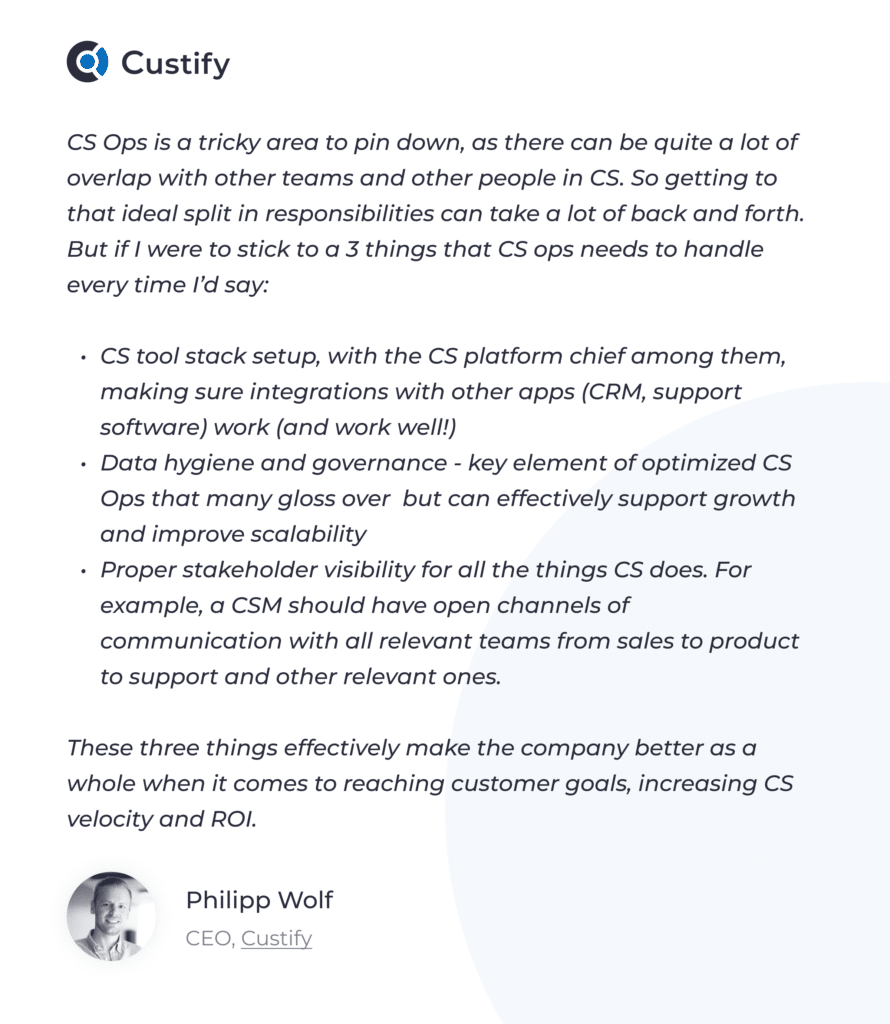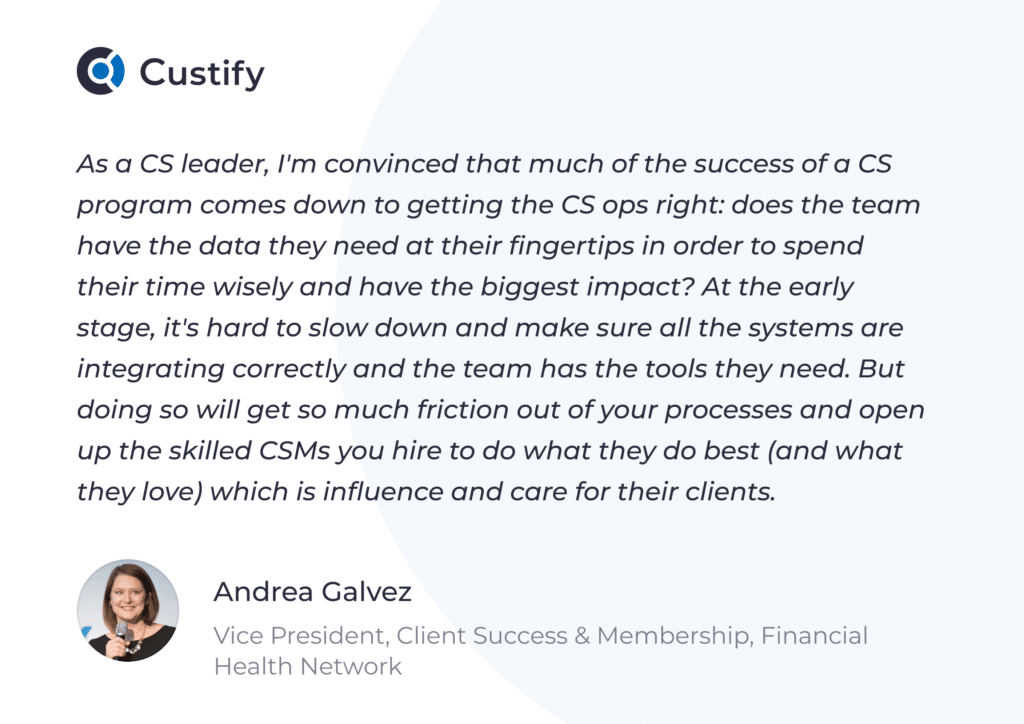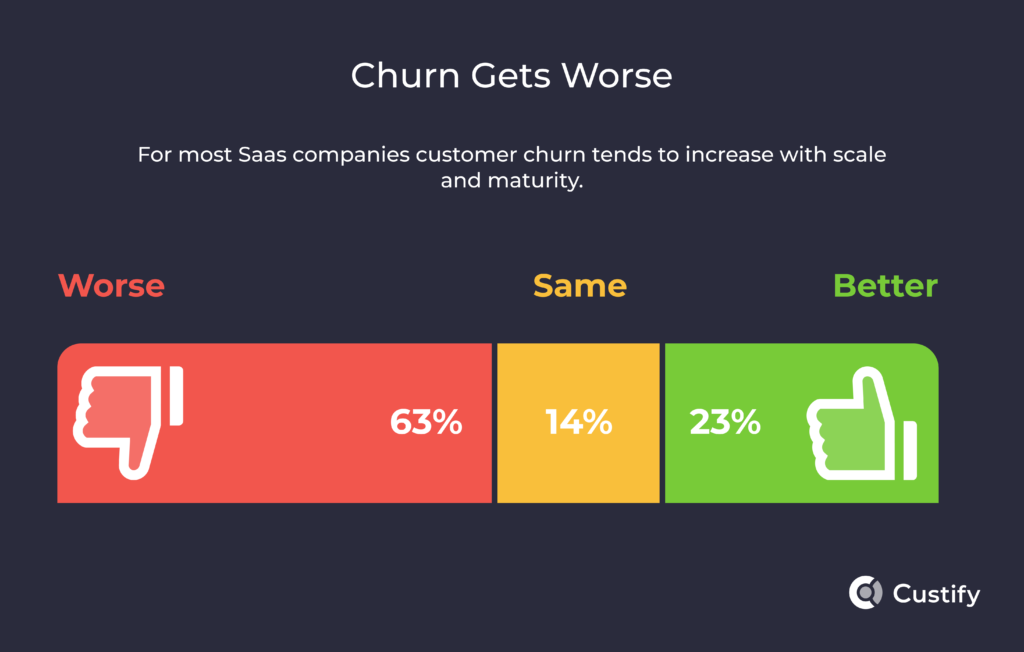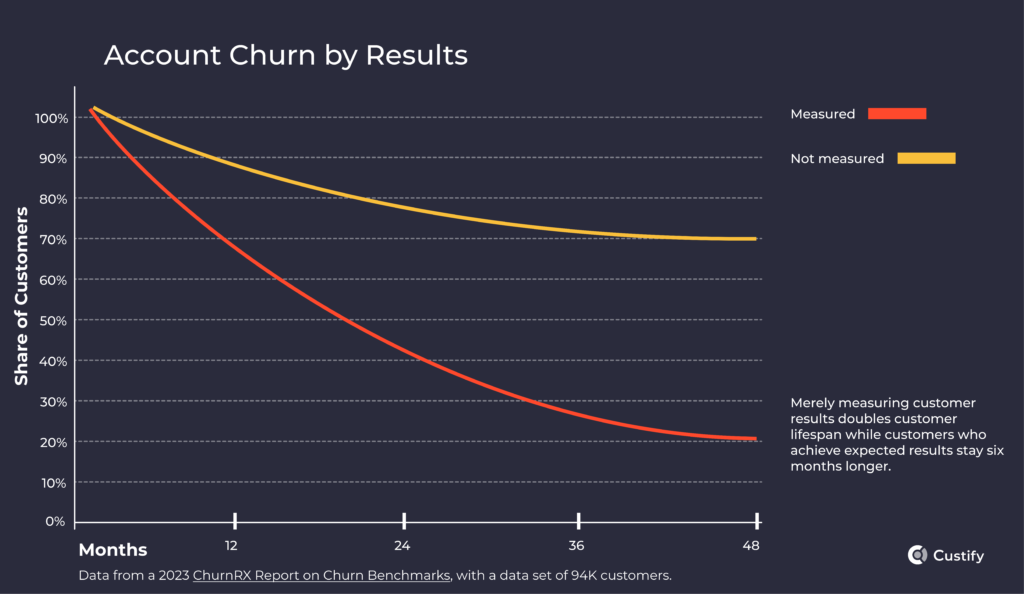In an ever-increasing number of insights we can pull from our survey on quiet quitting, we found that while just 9.2% of our respondents worked in CS Ops, 68.6% of them were, in fact, responsible for operations.
Shocking? Yes, I think so too.
Simple subtraction gets us to approximately 59.4% of CSMs who directly handle CS Ops despite not having a role in that area.
Today I’m going to make a case for CS Ops as a powerful, separate role in the CS team. We’ll start with the definition and move our way down through best practices, typical challenges, and proposed solutions with real insights from CS Ops people along the way. Let’s proceed!
What Is Customer Success Operations?
Customer Success Operations is a subdivision of customer success that handles tracking, metrics, workflows, tools, and tactics. CS Ops measures everything about customer success as well as many overarching business metrics, maintaining a bird’s-eye view of analytics, goals, KPIs, and customer and business outcomes.
The department plays a crucial role in ensuring that the tool stack is appropriate for the team’s budget, efficient in helping track all required metrics, equipped with automation to reduce CSM workload, and optimally set up with all the necessary integrations and stakeholders.
Once the tool stack and tracking elements are set up, CS Ops recenters on optimizing internal team processes, especially onboarding, renewals, upsells, and cross-sells, so they work in synergy with the selected tools.
Lastly, CS Ops punctuates their work by conducting reports from the data they aggregate. Throughout their efforts, the ops team follows a data hygiene approach to ensure the metrics are accurate and up to date.
What Does CS Ops Do Exactly?
For an easier overview, here’s a list of things that typically fall under CS Ops’ purview:
- Maintaining accurate and up-to-date data
- Creating reports based on tracked data
- Selecting, setting up, and managing the tool stack
- Optimizing onboarding, renewal, upsell, cross-sell, and other processes
- Streamlining workflows, tactics, playbooks, and strategies
- Planning and deploying customer surveys
- Maintaining an overview and making suggestions related to CS team size and structure
- Following data hygiene, intelligence, and governance principles and applying them throughout the organization
By performing these responsibilities, CS Ops ensures that the customer success team is operating at peak performance, leading to lower churn, better customer experiences, and overall business success.
Data from a 2023 ChurnRX Report on Churn Benchmarks, with a data set of 94K customers.
Optimized CS Ops: A Driver for Business Growth
Customer Success Operations is typically headed by either a Director of CS Ops or a CS Ops Manager. They set the tone for how customer success needs to function and what needs to happen for the team, the company, and their customers to succeed.
In an ideal world, all business organizations should follow a data-led and customer-centric strategy. While CS as a whole is responsible for the latter, the Ops part ensures everyone has a clear view of performance metrics at all times, knows the areas of improvement, and can make informed decisions toward customer and business outcomes.

Customer Success Operations Roles
CS Ops typically starts off with one person tasked with organizing existing CS workflows. As teams mature, however, they require more advanced roles.
These are the four most common roles within customer success teams:
- Customer Operations Specialist – Custify
- Customer Success Operations Analyst Job Description – Custify
- Customer Success Operations Manager – Custify
- Director of Customer Success Operations | Job Description
Ready to accelerate your career in customer success? Discover the best roles, opportunities, and insights about them in our Customer Success Career Path Hub.
“One of the more difficult choices you have to make when creating a CS Ops role is how to properly measure their performance. Most of the quantitative and measurable indicators (ARR, NRR, GRR, etc.) will be downstream from the individuals on this team. This makes it imperative that leaders create a performance structure that considers the position’s quantitative and qualitative aspects. It also means that you’ll need to establish trust and confidence between the CS Ops and CSM teams. You can achieve this through smart organizational design using matrix reporting structures and team-based goals.”
– Ben Childers, VP of Global Client Success at Engaging Networks
Best Practices: How to Approach Customer Success Operations
1. Plan for Scalable Success
The best thing CS ops can do is plan and work in a way that’s easy to scale once the company grows. In the initial stages of CS ops optimizations, it might be tiresome to ensure everything is perfectly scalable, but there are many reasons why you should try.
Finding a balance is the key to achieving success when starting your CS Ops initiatives. You need to weigh pros and cons of every facet of the scalable strategy and pick what makes the most sense to you and your business: some things might be great to do now, others can be postponed.

2. Optimize the Team Structure
CS Ops should have a say in how the team is structured to maximize efficiency both inside the CS team and throughout the organization (in a customer-centric way)
It’s one of the fundamental things that need to happen to ensure CS success. The people responsible for Ops need to:
- Be strategic and think about CS team structure when making suggestions
- Work with their peers to understand why the current team structure was selected and the risks associated with changes
- Be heard when they make their team-related suggestions
This is also an area where a single, entry-level CS analyst likely won’t make much headway on their own. They need support from either a manager or a director of CS operations to have any kind of impact on the structure of the CS department.
3. Track Everything that Matters to You and Your Customers
Let’s imagine this scenario:
Your company is measuring CSM performance based on churn rate. The lower the number of customers who churn, the better, right? At the same time, you’re also measuring product performance based on customer logins and time spent in product. If a customer likes the product, they’ll log in and spend a lot of time in it, right?
Both of these assumptions are wrong:
- First off, CS teams have an issue in today’s business landscape: they’re seen as a catch-all support department. It’s often their responsibility to keep churn in check over any other task. But if CSMs really want to be seen as what they are – revenue drivers – they need to refocus on expansion, growth, upsells, cross-sells – ways to impact business outcomes that could make any CFO go “wow!” – and it’s CS Ops’ task to track metrics tied to those tactics.
- Second, every product will have different metrics that indicate customers have succeeded. However, these metrics are very rarely logins and time spent in product, two of the most misleading metrics in CS. Instead, CS Ops needs to find out what the more relevant metrics are and track those.

Want to go down the CS data rabbit hole? We got you. Watch our webinar on The Role of Data with Irit Eizips, then sift through our CS Data eGuide to find out challenges, strategies, and more!
4. Use Tools to Be Efficient and Rise above the Clutter
CS operations is, as previously said, responsible for picking the best tools for the job. A simple customer success tool might be able to handle most of your daily requirements in CS, such as:
- Customer dashboards
- Product usage tracking
- Customer lifecycles
- Health scoring
- Automation
- Customer feedback
- Product feature tracking
- Customer engagement
- Reporting and analytics
- Task management and alerts
- Customer surveys
Apart from selecting the appropriate software for all of the above, CS Ops manages the stack and ensures they all work together to serve both business and customer outcomes adequately. Relating to the last point, you need to be able to track the right thing, the right way, and with precision. Only then can the business make informed decisions about CS without going into unnecessary budget or staffing cuts.
5. Prioritize the Creation of Cross-functional Alignment
A customer success operations person or team is necessary, but an aligned CS Ops team is better.
To put it simply: the best tools, the best metrics, the best processes won’t make your company aligned on what customer success is and how you can all work together towards it.
As such, CS needs to collaborate and align with other departments. To do that effectively, it’s important that CS Ops ensures they have all the collaborative tools available to them at all times. For example, a CSM must be able to tag a member of the product team in a conversation or task, and there has to be a mutual understanding that it’s ok to do so.
The precise collaboration processes will vary a lot based on your organization’s preferred way of working, but throughout, you need to ensure they’re built up for success.
For that, prioritize stakeholder visibility on all relevant internal processes and ensure cross-departmental alignment on customer goals and outcomes from the onset of your CS operations efforts.
Challenges and Solutions for Effective CS Ops
Customer success operations teams typically have a lot of roadblocks to successful implementation, which can become a drain on resources and a friction point leading to employee churn.
In what follows, I’ll list some common challenges and propose some solutions to them:
Challenge 1: Defining the Criteria for Customer Success
This is a big pain point for a lot of CS professionals because “success” means different things for different customers / customer segments. This, in turn, means tracking will be different based on the customer. And thus CS Ops’ work increases.
Solution:
To solve this, I suggest starting with a CS tool that can track different health scores per customer or group of customers (psst 🤫 Custify can do this). Then, to accurately find out what your customers care about, start a simple customer survey or go further with a voice-of-the-customer program.
Challenge 2: Tracking CS Ops Performances
Your customer success operations team may be great at implementing ways to track CS performance in what relates to customer and business outcomes, but CS Ops performance itself is difficult to measure. In fact, it would be easier to determine how they’re faring by looking at the CS team as a whole.
Solution:
The solution for this challenge is simple but often overlooked:
- Set clear responsibilities for each Ops role from the start
- Stick to SMART team-based goals to help with performance tracking
- Assign metrics to each responsibility
- Use a matrix reporting structure
Challenge 3: Scaling CS Ops

Credit: ChurnRX Report on Churn Benchmarks
CS ops specialists tend to implement solutions to operational problems in a way that prioritizes fixing those issues and increases CS velocity. Often the downside is they disregard that CS Ops itself needs to scale somewhere down the line.
Looking at the graphic above, we can see that most customer issues arise once the company grows. So then, a scaling mindset and plan might be the differentiating factor between businesses that take a nosedive and those that continue their natural growth.
Solution:
Start everything in CS Operations with scaling in mind. It’s better to do some prep work now than to completely redo your approach to operations once the company grows (a process that might take more time and resources than you have).
CS Ops Prevents CS oups…
In a world where CS constantly has to fight to prove its worth, Customer Success Operations is the best answer for both:
- Your customer success team. Having someone in the team tasked with making it efficient and tracking performance often feels like a dream. Most CSMs I know would welcome a dedicated ops person.
- Your C-level execs. The CEO and CFO need an ally inside the team that can tell it like it is, based on real datasets and the insights gained from them.
That concludes this short breakdown of CS Ops. If you found it useful, consider sharing it with your connections! And as always, don’t forget to check back in with the Custify Blog for more deep dives like this one.





